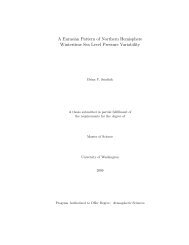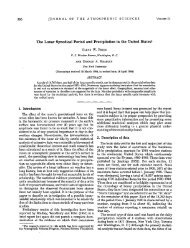Black carbon in Arctic snow and ice - Atmospheric Sciences ...
Black carbon in Arctic snow and ice - Atmospheric Sciences ...
Black carbon in Arctic snow and ice - Atmospheric Sciences ...
You also want an ePaper? Increase the reach of your titles
YUMPU automatically turns print PDFs into web optimized ePapers that Google loves.
<strong>Black</strong> <strong>carbon</strong> <strong>in</strong> <strong>Arctic</strong> <strong>snow</strong> <strong>and</strong> <strong>ice</strong>:<br />
Quantify<strong>in</strong>g its effect on surface albedo<br />
Tom Grenfell & Steve Warren<br />
Dept of <strong>Atmospheric</strong> <strong>Sciences</strong>, University of Wash<strong>in</strong>gton<br />
<strong>in</strong> collaboration with<br />
Tony Clarke (University of Hawaii)<br />
Other UW participants (past <strong>and</strong> future):<br />
Dean Hegg<br />
Sarah Doherty<br />
Mike Town<br />
Steve Hudson<br />
Hyun-Seung Kim (ESS)<br />
Jamie Morison, Andy Heiberg & Mike Steele(APL)<br />
Project website: www.atmos.wash<strong>in</strong>gton.edu/soot<strong>in</strong><strong>snow</strong>
The question that motivates this<br />
research:<br />
Why is the <strong>Arctic</strong><br />
warm<strong>in</strong>g so much faster<br />
than the global average?
Outl<strong>in</strong>e<br />
What affects <strong>snow</strong> albedo?<br />
Why are impurities so effective at reduc<strong>in</strong>g <strong>snow</strong> albedo?<br />
Why do impurities reduce <strong>snow</strong> albedo more than cloud albedo ?<br />
Measurement of black <strong>carbon</strong> (BC) <strong>in</strong> <strong>snow</strong><br />
Measurements to date<br />
Planned measurements<br />
Uncerta<strong>in</strong>ties <strong>in</strong> measur<strong>in</strong>g BC <strong>in</strong> <strong>snow</strong><br />
Uncerta<strong>in</strong>ties <strong>in</strong> model<strong>in</strong>g effect of BC on <strong>snow</strong> albedo<br />
Errors <strong>in</strong> albedo measurement<br />
Why remote sens<strong>in</strong>g is not useful to determ<strong>in</strong>e BC's effect<br />
on <strong>snow</strong> albedo<br />
Where <strong>and</strong> when does <strong>snow</strong> albedo matter for climate?
Beg<strong>in</strong>n<strong>in</strong>gs:<br />
NCAR 1978 Steve Warren & Warren Wiscombe, RT Model<strong>in</strong>g
What affects <strong>snow</strong> albedo?<br />
Gra<strong>in</strong> size (age)<br />
Variation of gra<strong>in</strong> size with depth<br />
Snow depth (& vegetation)<br />
Impurities: dust, black <strong>carbon</strong> (soot) – more effective for<br />
larger gra<strong>in</strong>s<br />
Sun angle<br />
density - if <strong>snow</strong> layer is th<strong>in</strong><br />
Why does albedo vary with wavelength:<br />
Absorption spectrum of <strong>ice</strong> - strongly wavelength dependent<br />
Very transparent at blue <strong>and</strong> near UV wavelengths<br />
Opaque <strong>in</strong> the near <strong>in</strong>frared <strong>and</strong> beyond<br />
New values recently published (Warren, Br<strong>and</strong>t, Grenfell,<br />
Applied Optics, 45, 5320, 2006)
Surface <strong>snow</strong> at South Pole
Snow Albedo<br />
Effect of <strong>snow</strong> gra<strong>in</strong> size (Wiscombe & Warren 1980)<br />
WW JAS I model
Interaction of sunlight with <strong>snow</strong><br />
To get the same number of refraction events, the distance traveled<br />
through <strong>ice</strong> is greater <strong>in</strong> coarse-gra<strong>in</strong>ed <strong>snow</strong>. Therefore, coarsegra<strong>in</strong>ed<br />
<strong>snow</strong> has lower albedo.<br />
Mostly refraction
Modelcalculated<br />
albedos were<br />
too high!<br />
Wiscombe &<br />
Warren 1980<br />
Grenfell &<br />
Maykut 1977,<br />
<strong>snow</strong> on <strong>Arctic</strong><br />
sea <strong>ice</strong>:<br />
dry new <strong>snow</strong><br />
wet new <strong>snow</strong><br />
old melt<strong>in</strong>g<br />
<strong>snow</strong><br />
Model albedos too high
Why are impurities so effective at reduc<strong>in</strong>g <strong>snow</strong> albedo?<br />
Because absorption by <strong>ice</strong> is very weak at visible wavelengths:<br />
<strong>ice</strong> is nearly transparent.<br />
Almost any additional absorption is significant.<br />
Impurities effective
Snow Albedo<br />
0.5ppm 0.05ppm<br />
0.05 ppm<br />
5 ppm<br />
0.5 ppm<br />
5 ppm<br />
Warren &<br />
Wiscombe<br />
JAS, 1980,<br />
RT Model<br />
Results<br />
WW JAS II dirty <strong>snow</strong>
Grenfell &<br />
Maykut<br />
(1977)<br />
Obs<br />
Warren<br />
(1982)<br />
RT Model<br />
GM 77 Observations
Grenfell Perovich & Ogren (CRST, 1981). Obs of albedos & impurities for<br />
alp<strong>in</strong>e <strong>snow</strong>. Dust ~ 20-60 ppm; maximum observed albedos between 0.8<br />
<strong>and</strong> 0.95. Clean <strong>snow</strong> ~0.98-0.99 from RT models. WWII values <strong>in</strong> range.<br />
GPO Observations
What impurities get <strong>in</strong>to <strong>snow</strong> that affect the albedo on a<br />
regional scale?<br />
Soot; W<strong>in</strong>dblown dust; volcanic ash; rafted sediments (sea<br />
<strong>ice</strong>); other exotic material of various colors on record.<br />
Many questions rema<strong>in</strong> about how the material gets <strong>in</strong>to the<br />
<strong>snow</strong>, but “clean” <strong>snow</strong> is not as common as we expected.
Where can we f<strong>in</strong>d clean <strong>snow</strong>?
South Pole Station, 1986<br />
South Pole
Warren & Clarke (JGR, 1990)<br />
Antarctic Plateau Soot
Grenfell, Warren, Mullen (1994) Hudson et al., J. Geophys. Res., 2006<br />
South Pole Dome C<br />
Observations consistent with RT models <strong>and</strong> soot concentrations<br />
Antarctic Plateau Spectral Albedo
Clarke & Noone A
AGASP 1 aircraft flights April 1983 <strong>and</strong> Snow Samples 1982-1983<br />
Range 1-120 ppb<br />
Most with<strong>in</strong> 5-50 ppb.<br />
Western Sector Only<br />
1983<br />
Clarke & Noone Map
Warren &<br />
Wiscombe<br />
(1985);<br />
Warren &<br />
Clarke<br />
(1986)<br />
Soot<br />
contents<br />
from Clarke<br />
& Noone<br />
(1985)<br />
Albedo Change vs Mass Fraction
Now, 20 years after Clarke & Noone (1985),<br />
there is renewed <strong>in</strong>terest <strong>in</strong> dirty <strong>snow</strong>.<br />
20 years after
Hansen & Nazarenko Proc. Nat. Acad. Sci. 2004
E<br />
i<br />
ΔTs<br />
/ Fi<br />
=<br />
ΔT<br />
/ F( CO )<br />
Soot <strong>in</strong> <strong>snow</strong> has the greatest<br />
efficacy of all climate forc<strong>in</strong>g<br />
components considered,<br />
because:<br />
(1) Peak of soot fallout (Spr<strong>in</strong>g)<br />
co<strong>in</strong>cides with onset of<br />
<strong>snow</strong>melt<br />
(2) Melt<strong>in</strong>g <strong>snow</strong> has lower<br />
albedo than cold <strong>snow</strong><br />
(3) Earlier melt exposes dark<br />
underly<strong>in</strong>g surface<br />
(4) Soot may concentrate at the<br />
surface dur<strong>in</strong>g melt<strong>in</strong>g (?)<br />
s<br />
Efficacy of <strong>snow</strong> albedo<br />
2
New Project was launched <strong>in</strong> 2006:<br />
A comprehensive survey of soot <strong>in</strong> <strong>Arctic</strong> <strong>snow</strong>,<br />
to update Clarke & Noone’s survey from 1983-4.
Outl<strong>in</strong>e<br />
What affects <strong>snow</strong> albedo?<br />
Why are impurities so effective at reduc<strong>in</strong>g <strong>snow</strong> albedo?<br />
Why do impurities reduce <strong>snow</strong> albedo more than cloud albedo?<br />
Measurement of black <strong>carbon</strong> (BC) <strong>in</strong> <strong>snow</strong><br />
Measurements to date<br />
Planned measurements Uncerta<strong>in</strong>ties <strong>in</strong> measur<strong>in</strong>g BC <strong>in</strong> <strong>snow</strong><br />
Uncerta<strong>in</strong>ties <strong>in</strong> model<strong>in</strong>g effect of BC on <strong>snow</strong> albedo<br />
Errors <strong>in</strong> albedo measurement<br />
Why remote sens<strong>in</strong>g is not useful to determ<strong>in</strong>e BC's effect<br />
on <strong>snow</strong> albedo<br />
Where <strong>and</strong> when does <strong>snow</strong> albedo matter for climate?<br />
Uncerta<strong>in</strong>ties <strong>in</strong> comput<strong>in</strong>g climatic effects of BC <strong>in</strong> <strong>snow</strong>
The Greenl<strong>and</strong> Ice Sheet
Transportation
Sample jars <strong>in</strong>serted <strong>in</strong>to the <strong>snow</strong><br />
Surface samples Depth profile
Sample Jars dug out
NE Greenl<strong>and</strong> Clean Tent
NE Greenl<strong>and</strong> Microwave Oven
Decant<strong>in</strong>g Melted Sample
Vacuum Filter<strong>in</strong>g
Snow at 96 km Snow at 38 km<br />
(~ 400 ml of meltwater was passed through each filter.)<br />
Filters will be analyzed for light transmission at multiple<br />
wavelengths to separate contributions by soot <strong>and</strong> dust. Greenl<strong>and</strong> filters
BC<br />
st<strong>and</strong>ards<br />
made by<br />
Tony<br />
Clarke<br />
“Monarch<br />
-71 soot”<br />
St<strong>and</strong>ard Filters
NSF project<br />
began 2006<br />
Sites samples<br />
to date <strong>in</strong> red<br />
Planned sites<br />
<strong>in</strong> green<br />
Our sites
HOTRAX voyage, Summer 2005 (Grenfell)<br />
<strong>Arctic</strong> Transect
Canada & Alaska, Spr<strong>in</strong>g 2006 & 2007: Tom Grenfell, Von Walden,<br />
Dave Barber & Co., Matt Nolan, Matthew Sturm<br />
<strong>Arctic</strong> Canada
Cambridge Bay, Nunavut 2006
Resolute Bay <strong>and</strong> sampl<strong>in</strong>g traverse April 2006. Green po<strong>in</strong>ts<br />
show the sample sites.<br />
Resolute
Konrad Steffen, Univ.<br />
Colorado.<br />
Automatic weather stations at<br />
2000-m level.<br />
Mike Town, Summit<br />
Lora Koenig, Swiss Camp<br />
Greenl<strong>and</strong>
Matthew Sturm (CRREL)<br />
March-April 2007<br />
Sturm Traverse 07
The Russian Federation<br />
Большая Карта
Соруководитель<br />
Dr. Vladimir<br />
Radionov<br />
<strong>Arctic</strong> <strong>and</strong><br />
Antarctic Research<br />
Institute<br />
St. Petersburg<br />
Victor<br />
Boyarsky<br />
VICAAR Polar Logistics<br />
Michael Lamak<strong>in</strong> & Valery Ippolitov
The quality of our shoes has been well tested for a long time.<br />
It is always strictly monitored – Peshekhod Shoe Center (<strong>in</strong> Siktivkar)<br />
Чувство Юмора
Prelim Effective Soot<br />
Concentration (ngC/g)<br />
1000<br />
100<br />
10<br />
Нарьян<br />
Мар<br />
Nar'yan<br />
Mar<br />
Воркута<br />
Vorkuta<br />
Хатанга<br />
Khatanga<br />
Диксон<br />
Dikson<br />
1<br />
0 50 100 150<br />
Site Index<br />
Наблюдение
Bronto<br />
Plan B<br />
Khatanga Transport
Vorkuta Transport
Results from NW<br />
Russia 2007<br />
Nar’yan Mar:<br />
Ave = 11 ppb<br />
Std Dev = 7 ppb<br />
Background ~ 5 ppb<br />
Vorkuta:<br />
Ave = 236 ppb<br />
Std Dev = 118 ppb<br />
‘Background’ ~ 90 ppb<br />
Khatanga:<br />
Ave = 36 ppb<br />
Std Dev = 30 ppb<br />
Background ~ 11 ppb<br />
Dikson:<br />
Ave = 20 ppb<br />
Std Dev = 24 ppb<br />
Background ~ 6 ppb<br />
Table of Values to date
In 20 years, the<br />
<strong>Arctic</strong> has become<br />
cleaner, by factors:<br />
1<br />
4<br />
2<br />
6<br />
<strong>Arctic</strong> is cleaner
Outl<strong>in</strong>e<br />
What affects <strong>snow</strong> albedo?<br />
Why are impurities so effective at reduc<strong>in</strong>g <strong>snow</strong> albedo?<br />
Why do impurities reduce <strong>snow</strong> albedo more than cloud albedo?<br />
Measurement of black <strong>carbon</strong> (BC) <strong>in</strong> <strong>snow</strong><br />
Measurements to date<br />
Planned measurements<br />
Uncerta<strong>in</strong>ties <strong>in</strong> measur<strong>in</strong>g BC <strong>in</strong> <strong>snow</strong><br />
Uncerta<strong>in</strong>ties <strong>in</strong> model<strong>in</strong>g effect of BC on <strong>snow</strong> albedo<br />
Errors <strong>in</strong> albedo measurement<br />
Why remote sens<strong>in</strong>g is not useful to determ<strong>in</strong>e BC's effect<br />
on <strong>snow</strong> albedo<br />
Where <strong>and</strong> when does <strong>snow</strong> albedo matter for climate?<br />
Uncerta<strong>in</strong>ties <strong>in</strong> comput<strong>in</strong>g climatic effects of BC <strong>in</strong> <strong>snow</strong>
Uncerta<strong>in</strong>ties <strong>in</strong> measur<strong>in</strong>g BC <strong>in</strong> <strong>snow</strong><br />
1. Incomplete capture of BC by the filter (Clarke & Noone got 85-88%)<br />
2. Inadequate dist<strong>in</strong>ction of BC from other absorbers (dust)<br />
3. Absorption coefficient will vary depend<strong>in</strong>g on type of soot<br />
But we don’t need the mass; we need only its effect on albedo; that’s why<br />
we use an optical method.<br />
The mass we report would be the true mass if the absorber <strong>in</strong> the sampled<br />
<strong>snow</strong> were identical to the soot used to make the weighed st<strong>and</strong>ards.<br />
4. Snow may be unrepresentative<br />
- contam<strong>in</strong>ated dur<strong>in</strong>g sampl<strong>in</strong>g (sooty clothes after cook<strong>in</strong>g)<br />
- too close to cities or research station
Greenl<strong>and</strong> Summit, July 2006 (Mike Town)<br />
Greenl<strong>and</strong> summit variations
Use of wavelength dependence of Absorption to separate Soot <strong>and</strong> Dust Absorption<br />
Kev<strong>in</strong> Noone & Tony Clarke<br />
Abisko, Sweden, 1984<br />
Soot filtered from <strong>snow</strong><br />
from above tree-l<strong>in</strong>e<br />
Dust from stream-flow<br />
above tree-l<strong>in</strong>e<br />
Soot<br />
Volcanic<br />
Ash dust<br />
reference<br />
Calibration<br />
soot<br />
Dust<br />
Separate soot dust ash spectral analysis
Uncerta<strong>in</strong>ties <strong>in</strong> translat<strong>in</strong>g from filter measurement<br />
to effect of BC on <strong>snow</strong> albedo<br />
1. The effective absorptive properties of soot particles depend on the<br />
refractive <strong>in</strong>dex of the surround<strong>in</strong>g medium. A soot particle on the<br />
surface of the nuclepore filter material may not have the same mass<br />
absorption cross-section as a soot particle on the surface of a <strong>snow</strong><br />
gra<strong>in</strong>.<br />
2. Soot particles are on the surface of the filter but may be embedded<br />
with<strong>in</strong> the <strong>snow</strong> particles, so k abs (soot on filter) differs from<br />
k abs (soot <strong>in</strong> <strong>snow</strong>).<br />
Uncerta<strong>in</strong>ty <strong>in</strong> comput<strong>in</strong>g effect on albedo as <strong>snow</strong> ages:<br />
1. Growth of <strong>snow</strong> gra<strong>in</strong>s<br />
2. Vertical redistribution of BC dur<strong>in</strong>g melt<strong>in</strong>g<br />
Filter <strong>in</strong>dex <strong>and</strong> age<strong>in</strong>g
Vertical redistribution of BC dur<strong>in</strong>g melt<strong>in</strong>g<br />
Do particles collect at the surface as the <strong>snow</strong> melts?<br />
Soot collect<strong>in</strong>g at surface?
Conway et al., Albedo of dirty <strong>snow</strong> dur<strong>in</strong>g conditions of melt,<br />
Water Resources Res., 1996<br />
Migration of soot with melt<strong>in</strong>g refs
Sources of error <strong>in</strong> albedo measurement<br />
1. Imperfect cos<strong>in</strong>e-collector (deviation from cos<strong>in</strong>e response varies<br />
with wavelength, <strong>and</strong> correction varies with diffuse-fraction of<br />
<strong>in</strong>cident radiation)<br />
2. Imperfect level<strong>in</strong>g of <strong>in</strong>strument<br />
Albedo errors A
Sources of error <strong>in</strong> albedo measurement<br />
1. Imperfect cos<strong>in</strong>e-collector (deviation from cos<strong>in</strong>e response varies<br />
with wavelength, <strong>and</strong> correction varies with diffuse-fraction of<br />
<strong>in</strong>cident radiation)<br />
2. Imperfect level<strong>in</strong>g of <strong>in</strong>strument<br />
3. Slop<strong>in</strong>g surface:<br />
Albedo errors B
Sources of error <strong>in</strong> albedo measurement<br />
1. Imperfect cos<strong>in</strong>e-collector (deviation from cos<strong>in</strong>e response varies<br />
with wavelength, <strong>and</strong> correction varies with diffuse-fraction of<br />
<strong>in</strong>cident radiation)<br />
2. Imperfect level<strong>in</strong>g of <strong>in</strong>strument<br />
3. Slop<strong>in</strong>g surface:<br />
4. Sampl<strong>in</strong>g of bumps (sastrugi)<br />
(These 4 errors are much smaller under overcast sky.)<br />
Albedo errors C
Sastrugi
Sources of error <strong>in</strong> albedo measurement (cont<strong>in</strong>ued)<br />
5. Fluctuations of <strong>in</strong>cident irradiance under cloud (need to monitor<br />
this)<br />
6. Shadow<strong>in</strong>g correction (can be made
Why remote sens<strong>in</strong>g is not useful to determ<strong>in</strong>e BC's effect<br />
on <strong>snow</strong> albedo<br />
1. It's hard to dist<strong>in</strong>guish <strong>snow</strong> from clouds-over-<strong>snow</strong>. Th<strong>in</strong> near-surface<br />
layers of atmospheric <strong>ice</strong> crystals ("diamond-dust") are common <strong>in</strong> the<br />
<strong>Arctic</strong>.<br />
2. The bidirectional reflectance (BRDF) is affected by small-scale surface<br />
roughness: ripples, sastrugi, suncups, pressure-ridges.<br />
(The effects of sastrugi on BRDF are different at different wavelengths,<br />
because they depend on the ratio of sastrugi width to flux-penetration<br />
depth.)<br />
3. When a th<strong>in</strong> ground-fog (or diamond-dust layer) covers the rough <strong>snow</strong>,<br />
the forward peak is enhanced <strong>and</strong> the nadir view is darker, even though<br />
the albedo is probably unchanged or slightly higher. This darken<strong>in</strong>g at<br />
nadir could be mistaken for soot-contam<strong>in</strong>ation.<br />
4. Gra<strong>in</strong> shape affects BRDF (even if does not affect albedo).<br />
Remote sens<strong>in</strong>g not useful<br />
A
Surface Frost on West Antarctica<br />
(Photo by Nad<strong>in</strong>e Nereson)
Why remote sens<strong>in</strong>g is not useful to determ<strong>in</strong>e BC's effect<br />
on <strong>snow</strong> albedo (cont<strong>in</strong>ued)<br />
5. Increase of gra<strong>in</strong> size with depth reduces visible albedo more than near-<br />
IR albedo, masquerad<strong>in</strong>g as soot.<br />
6. Albedo reduction by BC <strong>in</strong> <strong>snow</strong> can be mimicked:<br />
- by th<strong>in</strong> <strong>snow</strong>. Sooty <strong>snow</strong> has the same spectral signature as th<strong>in</strong> <strong>snow</strong>.<br />
<strong>Arctic</strong> <strong>snow</strong> is th<strong>in</strong> <strong>in</strong> many places.<br />
- by sub-grid-scale leads <strong>in</strong> the <strong>Arctic</strong> Ocean.<br />
- by BC <strong>in</strong> the atmosphere above the <strong>snow</strong> ("<strong>Arctic</strong> haze").<br />
Remote sens<strong>in</strong>g not useful B
Where <strong>and</strong> when does variation of <strong>snow</strong> albedo matter for climate?<br />
Whenever <strong>snow</strong> is exposed to significant solar energy<br />
(<strong>snow</strong> albedo is less important <strong>in</strong> w<strong>in</strong>ter <strong>and</strong> <strong>in</strong> boreal forest)<br />
<strong>Arctic</strong> <strong>snow</strong><br />
- Tundra <strong>in</strong> spr<strong>in</strong>g<br />
- Sea <strong>ice</strong> <strong>in</strong> spr<strong>in</strong>g (covered with <strong>snow</strong>)<br />
- Greenl<strong>and</strong> Ice Sheet <strong>in</strong> spr<strong>in</strong>g (cold <strong>snow</strong>)<br />
- Greenl<strong>and</strong> Ice Sheet <strong>in</strong> summer (melt<strong>in</strong>g <strong>snow</strong>)<br />
Non-<strong>Arctic</strong> <strong>snow</strong><br />
- Great Pla<strong>in</strong>s of North America<br />
- Steppes of Asia: Kazakhstan, Mongolia, X<strong>in</strong>jiang, Tibet<br />
Glacier <strong>ice</strong> <strong>and</strong> sea <strong>ice</strong> are also important:<br />
- Ablation zone of Greenl<strong>and</strong> Ice Sheet <strong>in</strong> summer<br />
- <strong>Arctic</strong> ocean <strong>in</strong> summer<br />
Where <strong>and</strong> when does soot matter?
Summary of our Strategy<br />
Climatic effect of BC on <strong>snow</strong> albedo is expected to be at most a<br />
few percent, <strong>and</strong> <strong>snow</strong> albedo depends on several other<br />
variables. Therefore we do not directly measure the albedo<br />
reduction. Instead:<br />
1. Collect <strong>snow</strong> samples, melt <strong>and</strong> filter them. Analyze the filters<br />
for BC <strong>and</strong> dust.<br />
2. Use the BC amount together with <strong>snow</strong> gra<strong>in</strong> size <strong>in</strong> a radiativetransfer<br />
model to compute albedo reduction - comparison with<br />
selected albedo observations.<br />
3. Direct measurement of albedo-reduction (to verify the model<strong>in</strong>g)<br />
may be possible where all other variables are constant: e.g. a<br />
transect outward from a pollution source.
Summary 1. Reduction of albedo<br />
To reduce albedo of old melt<strong>in</strong>g <strong>snow</strong><br />
by 1% requires mass fractions:<br />
~10 ppb black <strong>carbon</strong> (soot)<br />
~500 ppb soil dust<br />
~1000 ppb volcanic ash
Summary 2. Prelim<strong>in</strong>ary results.<br />
Median BC values <strong>in</strong> Greenl<strong>and</strong> are <strong>in</strong> the same range as found by<br />
Clarke & Noone (1985).<br />
Median background values from Canada, Alaska, <strong>and</strong> the <strong>Arctic</strong><br />
Ocean are lower by factors of 2-6 than <strong>in</strong> early 1980’s.<br />
Background values from NW Russia are ~5-20 ppb<br />
Quantification ref<strong>in</strong>ements due shortly:<br />
new spectrophotometer to analyze filters<br />
new st<strong>and</strong>ards
Summary 3. Uncerta<strong>in</strong>ties <strong>in</strong> comput<strong>in</strong>g climatic effects<br />
of BC <strong>in</strong> <strong>snow</strong>:<br />
BC content of <strong>snow</strong>: <strong>in</strong>adequate temporal <strong>and</strong> spatial sampl<strong>in</strong>g<br />
Seasonal variation<br />
Geographical variation<br />
Vertical redistribution<br />
Effect on <strong>snow</strong> albedo: variations of<br />
Snow gra<strong>in</strong> size (varies seasonally <strong>and</strong> geographically)<br />
Snow depth<br />
Importance of <strong>snow</strong> albedo for climate: what is hid<strong>in</strong>g the <strong>snow</strong>?<br />
Vegetation cover<br />
Cloud cover<br />
Cloud thickness
Planned Activities<br />
1. Survey (update of Clarke & Noone 1985)<br />
(exp<strong>and</strong> to eastern <strong>Arctic</strong>, several years at all possible locations)<br />
Additional data needed from: <strong>Arctic</strong> tundra, <strong>ice</strong> sheets & sea <strong>ice</strong> <strong>in</strong> Alaska,<br />
Canada, Greenl<strong>and</strong>, Russia, <strong>Arctic</strong> Ocean, Sc<strong>and</strong><strong>in</strong>avia<br />
March-May (time of maximum <strong>snow</strong> depth, sample deposition at several<br />
vertical levels – <strong>in</strong>tra-annual variations)<br />
Summer: Greenl<strong>and</strong> Ice Sheet (melt<strong>in</strong>g <strong>snow</strong>), <strong>Arctic</strong> Ocean (melt<strong>in</strong>g sea <strong>ice</strong>).<br />
Who: Our group + Volunteers<br />
2. Process studies<br />
Scaveng<strong>in</strong>g ratio for BC <strong>in</strong> <strong>snow</strong>fall<br />
Vertical redistribution of BC with melt<strong>in</strong>g<br />
Characterization of soot by source type<br />
3. Methods comparison with Gerl<strong>and</strong>, Berntsen<br />
4. Collaborate on source attribution with Dean Hegg (PC/factor analysis) +<br />
Planned Activities
<strong>Arctic</strong> Russia<br />
March-May 2007/ 08<br />
Tom Grenfell, Steve Hudson, Steve Warren<br />
<strong>Arctic</strong> Russia 2007-08
Jim Hansen<br />
for <strong>in</strong>spir<strong>in</strong>g us to take on this project<br />
Ellen Baum <strong>and</strong> the Clean Air Task Force<br />
for gett<strong>in</strong>g us go<strong>in</strong>g with foundation fund<strong>in</strong>g<br />
(Torrance, Redman, Hatch, Kendall, Oak)<br />
NSF <strong>Arctic</strong> Program<br />
Thanks to:<br />
Our volunteer force for greatly extend<strong>in</strong>g coverage of our results<br />
Polar Cont<strong>in</strong>ental Shelf Project of Canada<br />
for logistics support at Resolute, Nunavut<br />
Danish Polar Center<br />
for logistics support <strong>in</strong> northeast Greenl<strong>and</strong><br />
Russian Hydrometeorological Servive<br />
for support <strong>and</strong> permissions for northern Russia










